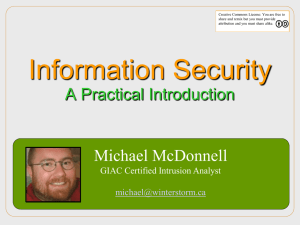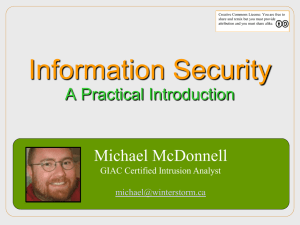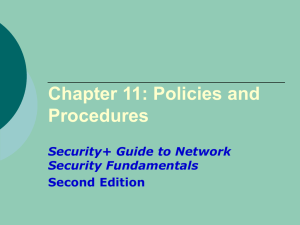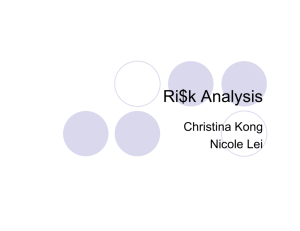File - Headwall Security
advertisement
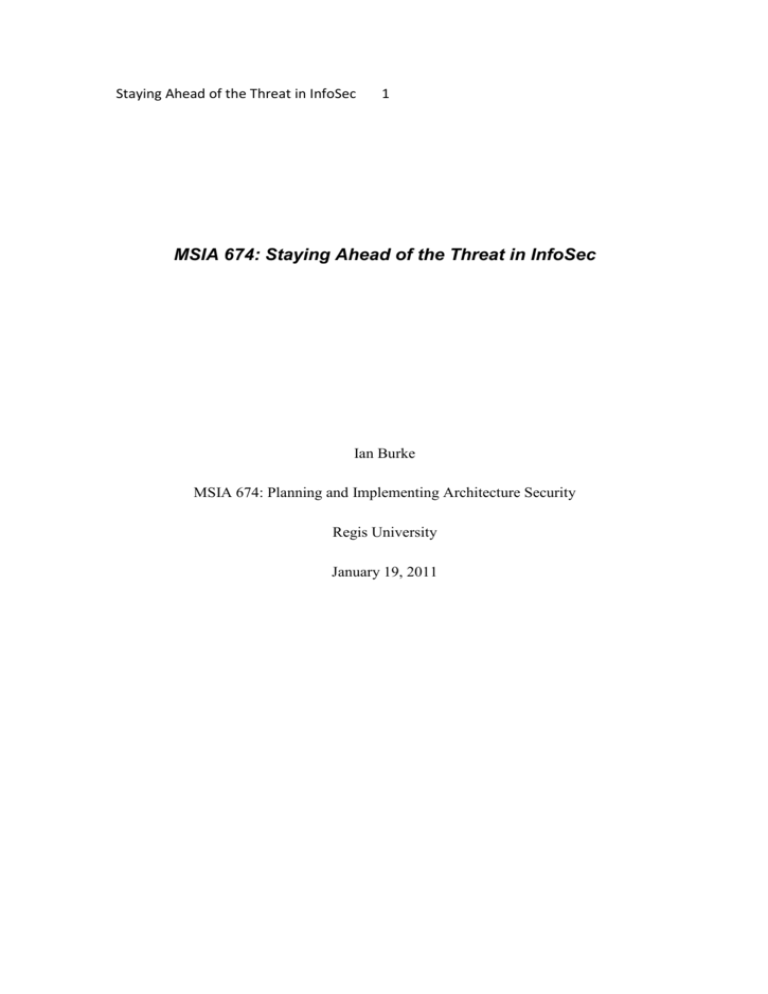
Staying Ahead of the Threat in InfoSec 1 MSIA 674: Staying Ahead of the Threat in InfoSec Ian Burke MSIA 674: Planning and Implementing Architecture Security Regis University January 19, 2011 Staying Ahead of the Threat in InfoSec 2 Abstract The history of the infosec professional tells a lot about how they stay informed about the latest threat. In the past there were hackers who set out to discover what they could learn about computer systems. Their intent was not malicious but their skill and craft was undeniable. Over time this group divided into white hat hackers and black hat hackers; good and bad respectively. Both continued to practice the craft of “hacking”, one with the intent of protecting systems, discovering weaknesses, and raising awareness. The other had more malicious intents. Today, white hat hackers have become ethical hackers, pen testers, and security professionals. They stay current by practising their craft, reading and studying whatever they can and staying current on vendor vulnerability notices. It is a constant struggle to stay current with the other side of the community as it continues to do the same with a much darker objective. Keywords: infosec, hacker, threat, vulnerability, CEV, ethical hacker. Discussion There are many different tools available for the security professional to stay informed of the current threats today. Perhaps one of the most important steps is to stay aware of their current environment and its vulnerabilities. From this they are Staying Ahead of the Threat in InfoSec 3 better prepared to know what threats to track in the wild. There is also a need for the security professional to be vigilant at staying informed of the current trends in the world of the attacker. There are tools available for this as well. The educators and practitioners at EC-Counsel advise their students to frequent the same message boards and RSS feeds that the black hat hacker community subscribes too. (“EC-Council Security Administrator”. 2010.) But how we accomplish these tasks is perhaps the biggest question facing security professionals? With the proliferation of information and the abundance of resources, the lack of information can be stifling if one does not know where to look. In order to know your own network and resources a company must perform a risk assessment at some point. A risk assessment will provide information about the critical assets in the company but more importantly about the vulnerabilities facing those assets. Young identifies a risk cycle where he walks a threat through the process of matching it to the risks identified in the organization an then the mitigation process. The important piece to Young process is that it is a cycle that loops back on itself and re-assesses the threat after the mitigation process. (Young. 2010.) Other models for the risk management process look across the organization and identify the threats facing the assets in the organization by looking at the vulnerabilities facing those assets. This is the next big challenge for many security professionals. Often it is not their challenge but the challenge of the other members of the IT team. Staying Staying Ahead of the Threat in InfoSec 4 current on vulnerabilities. The common vulnerability reports are perhaps one of the best resources. (Mitre.) This report is also provided in a different format through the Department of Homeland Security on their National Vulnerability Database. (NIST) These reports of vulnerabilities along with notices directly from vendors, such as patch updates, provide fairly strong resources for keeping current on the vulnerabilities facing your assets. These are the same reports that feed tools such as the open source vulnerability scanner, Nessus. This information provides some of the most current information around weaknesses in systems and software. This is the point at which many security professionals stop. The practice of ethical hacking teaches us that there are resources available to stay current with the practices of the not so ethical hacking community. Much of the hacking community still communicates through IRC channels and more currently through secured and secret blog sites. The challenge is finding these sites and gaining access to them. It is important to remember that the attackers are faced with the same challenges that we as security professionals are. While we are trying to find out what skills they poses, they are doing the same against us. While we are working to stay current on the vulnerabilities in the technology that is deployed in our infrastructure, they are doing the same. These attackers will be at the same conferences, and researching on the same message boards that you will. Making a presence for yourself in these spaces will help to make you credible. The challenge is that you must present to the security world as a security professional, but to the hacker world you want to have a presence that may be able to offer them something less than ethical. In this way you Staying Ahead of the Threat in InfoSec 5 may be able to gain access to their secret message boards and chat sessions. (“Certified Ethical Hacker”. 2010.”) Message boards, RSS feeds and blogs, whether from the hacker community or from vendors and government sites can also be a good way to stay current on security threats. Anti virus vendors such as Symantec and Sophos maintain RSS feeds, as well as mobile device applications, which provide current threat awareness and zero-day updates. RSS feeds such as Hell Bound Hackers can provide information on current news and malware such as Stuxnet. (Korg. 2010.) It is important to mix mainstream data sources such as vendors and government sites, with community sites that may not be vetted by a company or institution. This will open you data sources to the potential of information from the community while vetting your information against reputable sources. Also remember that tool sets, such as Metasploit and Nessus, while once open source tools are often owned by major corporations today. An RSS feed with these names may simply be a feed from one of these companies. One of the greatest communication channels we have today is the advent of social media such as Twitter or Facebook. These should not be discounted when looking to learn about threats. If a security professional learns of a new threat, there is merit to hoping onto a site such as Twitter and seeing what the community is saying about that new threat. For example, a search on Twitter for Kneber you will see a posts to the social stream relating to the Kneber botnet. (Real Time Results for Staying Ahead of the Threat in InfoSec 6 Kneber. 2010.) Above all else the security professional needs to stay educated. It is difficult to find the education channel that works best for the individual. With boot camps, conferences and new college programs, there are many options. The important thing is for the security professional to chose one that works for them and to be vigilant on staying current with the new technologies, practices and methods in the security space. Conclusion Staying current as an InfoSec professional is a challenge today. It is more than simply taking a class or achieving the latest certification. With new threats which may have the potential to change the landscape of of governments and economies, such as Stuxnet, emerging every day, the security professional needs to be diligent at staying current with threat awareness. The threats facing our infrastructures are more awesome than any individual security professional could ever master. As an individual, starting by mastering the vulnerabilities at home is a strong starting place. Tools such as CVE reports and vulnerability scanners help to build that base. Expanding that knowledge into the zero day awareness and the hacker knowledge base is the next challenge. Blogs, readers and message board are the home to this knowledge. It is important that this information be a strong mix of Staying Ahead of the Threat in InfoSec 7 commercial, private, and government sites so that the information gathered has a strong vetting and knowledge source. The challenges of staying current as an InfoSec professional is more of an art than a skill. References Certified Ethical Hacker Courseware. (2010). EC-Counsil. Singapore. EC-Council Security Administrator/Licensed Penetration Tester Couseware v4. (2010). EC-Counsil. Singapore. Korg. Stuxnet Mallware is Weapon Out To Destroy. Retrieved From: Hell Bound Hackers. RSS Feed. Http://hellboundhackers.org/news/rss.xml. (September 27, 2010). Mitre. Common Vulnerability and Exposures. Retrieved from: http://cve.mitre,org. NIST. National Vulnerability Database. Department of Homeland Security. National Institute of Standards and Technology. Retrieved from: http://nvd.nist.gov Real time Results for Kneber. Retrieved from: Twitter. http://twitter.com/#search? q=Kneber . (December 23, 2010.) Young. (2010). Metrics and Methods for Security Risk Management. 47-60. Syngress. New York.


